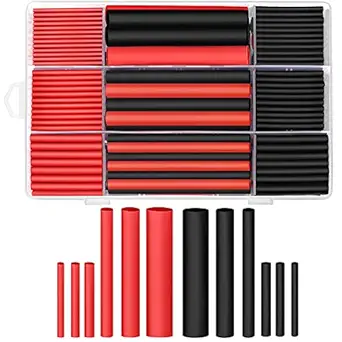The Ultimate Buying Guide for Heat Shrink Tubing
Overview
Heat shrink tubing is a versatile and useful product for anyone working with electronics or DIY projects. It provides a simple and effective way to insulate wires, protect cables, and manage cords. With so many different types, sizes, and materials available, choosing the right heat shrink tubing can be overwhelming. This guide will help you navigate the options and make an informed decision.
Types
1. Polyolefin Heat Shrink Tubing: This is the most common type of heat shrink tubing and is suitable for a wide range of applications. It is flexible, durable, and offers good electrical insulation properties.
2. Adhesive-Lined Heat Shrink Tubing: This type of tubing has an adhesive lining that melts and flows when heated, creating a watertight seal. It is ideal for outdoor and marine applications.
3. Dual-Wall Heat Shrink Tubing: This tubing has an outer layer of polyolefin and an inner layer of adhesive. It provides extra protection against moisture, chemicals, and abrasion.
4. High-Temperature Heat Shrink Tubing: This tubing is designed to withstand extreme temperatures and is often used in industrial applications.
5. Specialty Heat Shrink Tubing: There are many other types of heat shrink tubing available for specific applications, such as flame-retardant, color-coded, and low-smoke.
Key Considerations
1. Size: Heat shrink tubing comes in a variety of sizes, so it's important to choose the right size for your application. Measure the diameter of the wire or cable you want to cover and choose tubing that is slightly larger.
2. Temperature Range: Consider the temperature range of your application and choose tubing that can withstand those temperatures.
3. Voltage Rating: Make sure the tubing is rated for the voltage of your application.
4. UL Certification: Look for tubing that has been certified by Underwriters Laboratories (UL) to ensure it meets safety standards.
5. RoHS Compliance: If you need tubing that is free of hazardous materials, look for tubing that is RoHS compliant.
Features
1. Color Coding: Some heat shrink tubing comes in different colors, which can be useful for organizing wires and cables.
2. Corrosion Resistance: Look for tubing that is resistant to chemicals and moisture if you need to protect your wires and cables from corrosion.
3. Flame Retardant: If you're working with high-temperature applications, choose tubing that is flame retardant.
Prices
Heat shrink tubing prices vary depending on the size, material, and quantity. Generally, you can expect to pay between $0.10 and $1.00 per foot.
Tips
1. Use a heat gun or lighter to shrink the tubing evenly and avoid overheating.
2. Choose tubing that is slightly larger than the wire or cable you want to cover to ensure a snug fit.
3. Test the tubing on a small section of wire or cable before using it on a larger scale.
FAQs
Q: How do I choose the right size of heat shrink tubing?
A: Measure the diameter of the wire or cable you want to cover and choose tubing that is slightly larger.
Q: Can I use a lighter to shrink the tubing?
A: Yes, but a heat gun is recommended for more even and controlled heating.
Q: How do I know if the tubing is rated for the voltage of my application?
A: Check the manufacturer's specifications for voltage rating.
Q: Can I use heat shrink tubing for outdoor applications?
A: Yes, choose tubing that is resistant to moisture and UV rays.
Q: Is heat shrink tubing reusable?
A: No, once the tubing has been heated and shrunk, it cannot be reused.
Conclusion:
Heat shrink tubing is an essential product for anyone working with electronics or DIY projects. By considering the types, key considerations, features, prices, and tips outlined in this guide, you can choose the right tubing for your application and ensure a successful project.














